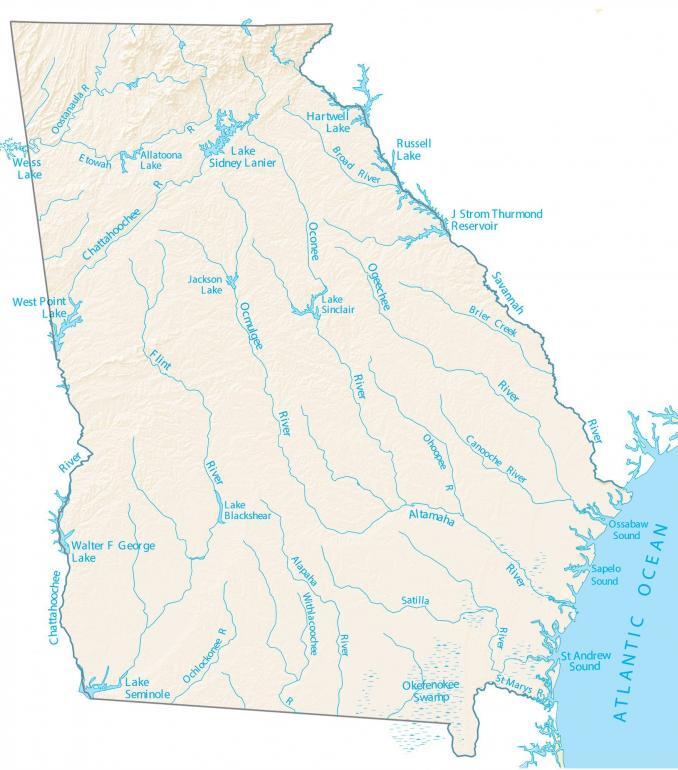Georgia, a state located in the southeastern region of the United States, is home to many rivers that are vital to the state’s economy and environment. The rivers in Georgia serve many purposes, including providing a source of drinking water, supporting recreational activities such as fishing and boating, and providing a habitat for a wide variety of plant and animal species.
Georgia Rivers Map (USA)

There are many rivers in Georgia, each with its own unique features and characteristics. In this essay, we will provide detailed information about every river in Georgia, including their length, location, and notable features.
- Chattahoochee River: The Chattahoochee River is one of the longest rivers in the Georgia rivers map, stretching over 430 miles from its headwaters in the Blue Ridge Mountains to its confluence with the Flint River at Lake Seminole. The river serves as the primary water source for the city of Atlanta and provides recreational opportunities such as fishing, boating, and swimming. The Chattahoochee River National Recreation Area, which spans 48 miles along the river, is a popular destination for hiking, biking, and picnicking.
- Savannah River: The Savannah River flows along the border between Georgia and South Carolina for over 300 miles, beginning in the Blue Ridge Mountains and ending at the Atlantic Ocean. The river is used for navigation, power generation, and recreation, with several parks and boat ramps located along its banks. The Savannah River is also a critical source of drinking water for many communities in Georgia and South Carolina.
- Altamaha River: The Altamaha River is the second-largest river system in the Georgia rivers map, stretching over 137 miles from its headwaters in the Piedmont region to the Atlantic Ocean. The river flows through several counties and serves as a vital habitat for many fish and wildlife species, including the endangered Altamaha spinymussel. The Altamaha River is also popular for fishing, boating, and camping.
- Ocmulgee River: The Ocmulgee River is a 255-mile-long river that begins in the Piedmont region of the Georgia rivers map and flows southward to its confluence with the Oconee River to form the Altamaha River. The river is named after the Ocmulgee National Monument, which is located along its banks and contains prehistoric Native American mounds and artifacts. The Ocmulgee River also provides important habitat for fish and wildlife species and is popular for boating and fishing.
- Oconee River: The Oconee River is a 220-mile-long river on the Georgia rivers map that begins in the Blue Ridge Mountains and flows southeastward to its confluence with the Ocmulgee River to form the Altamaha River. The river is used for navigation, power generation, and recreation, with several parks and boat ramps located along its banks. The Oconee River also provides habitat for a variety of fish and wildlife species, including the endangered Altamaha spinymussel.
- Flint River: The Flint River is a 344-mile-long river that begins in the Piedmont region of the Georgia rivers map and flows southward to its confluence with the Chattahoochee River to form Lake Seminole. The river is used for irrigation, recreation, and drinking water, with several parks and boat ramps located along its banks. The Flint River is also home to many fish and wildlife species, including the shoal bass and American shad.
- Coosa River: The Coosa River is a 280-mile-long river that begins in the Georgia rivers map and flows southwestward through Alabama and into the Gulf of Mexico. The river is used for navigation, power generation, and recreation, with several parks and boat ramps located along its banks. The Coosa River is also home to many fish and wildlife species, including the Coosa striped bass and the federally endangered frecklebelly madtom.
- Tallapoosa River: The Tallapoosa River is a 265-mile-long river that begins in the Georgia rivers map and flows southwestward through Alabama and into the Coosa River. The river is used for recreation, with several parks and boat ramps located along its banks. The Tallapoosa River is also home to many fish and wildlife species, including the federally endangered Alabama sturgeon.
- Satilla River: The Satilla River is a 235-mile-long river that begins in the Georgia rivers map and flows southeastward to the Atlantic Ocean. The river is used for recreation, with several parks and boat ramps located along its banks. The Satilla River is also home to many fish and wildlife species, including the shoal bass and the rare eastern indigo snake.
- St. Marys River: The St. Marys River is a 130-mile-long river that forms part of the border between the Georgia rivers map and Florida before flowing into the Atlantic Ocean. The river is used for recreation, with several parks and boat ramps located along its banks. The St. Marys River is also home to many fish and wildlife species, including the Gulf sturgeon and the striped newt.
In addition to these rivers, there are many other smaller rivers and streams throughout Georgia that are important for their ecological and recreational value. These include the Etowah River, the Conasauga River, the Toccoa River, and the Little River.
Overall, the rivers of Georgia are essential resources that provide numerous benefits to the state’s economy and environment. From providing a source of drinking water to supporting recreational activities such as fishing and boating, these rivers play a critical role in the daily lives of Georgians. Moreover, they provide vital habitat for a wide variety of plant and animal species and help maintain the health of Georgia’s ecosystems. It is important to continue to protect and preserve these rivers and their associated habitats to ensure their long-term sustainability and availability for future generations.

